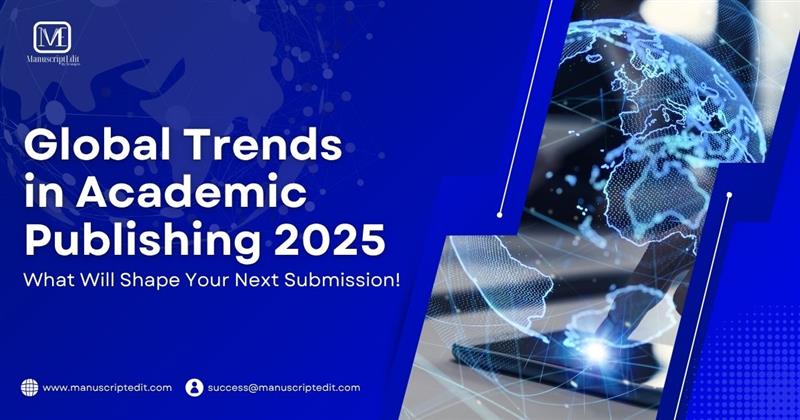Table of Contents
Why 2025 is different
Academic publishing has crossed a threshold. In 2025, the most visible papers will be those that are clearer, more compliant, and more discoverable—not just more novel. Open access models are expanding; funders are tightening public access and data sharing; integrity tools are scaling; and AI is now embedded in writing and review workflows—yet must be disclosed and governed responsibly. For authors and research managers, the right response is a workflow shift: plan open access early, design for integrity, use AI assistively (never as authorship), and optimise for discovery.
Below, we unpack seven trends—and the concrete steps to take this month. We also include geo-specific tips for USCAN, EMEA, APAC, and ANZ audiences.
1) Open access is strategic, not optional
What’s changing.
Gold/hybrid routes and transformative agreements continue to expand. Many institutions underwrite or discount APCs for specific journals, while funders increasingly require immediate access to articles and data.
What to do now.
• Decide your open access route during journal selection (instead of at acceptance).
• Check your institution’s transformative agreements and APC waivers.
• Align licence (e.g., CC BY) and data availability language with funder and journal policy.
2) Compliance moves to the front of the workflow
What’s changing.
Funders and institutions now expect immediate public access to the accepted or published version, with repository deposit, data/code statements, and licence clarity. Policies are also clarifying expectations for AI use.
What to do now.
• Add a compliance checkpoint to your submission plan: funding text, data/code availability, repository choice, and licence selection.
• Keep an Author Accepted Manuscript (AAM) version ready for deposit.
• If you use tools (including AI) in drafting or editing, prepare a transparent disclosure aligned to journal policy.
3) Integrity tech scales up (paper mills, image forensics)
What’s changing.
Publishers and industry groups are collaborating to detect paper-mill patterns, image manipulation, and other integrity risks. Expect more screening at submission and during review.
What to do now.
• Maintain raw data and provenance for images; avoid over-editing figures.
• Keep a methods logbook (software versions, parameters, scripts).
• Use plagiarism/duplication checks ethically before submission, then interpret results with human judgement.
4) Responsible AI becomes normal—but not authorship
What’s changing.
AI is widely used for language polishing, terminology consistency, and formatting, yet cannot be an author and must not replace scholarly judgement. Review organisations and journals increasingly require AI disclosure.
What to do now.
• Treat AI as assistive: grammar, structure, reference hygiene.
• Keep human substantive editing for logic, argument, and field conventions.
• Document if/where AI tools were used; disclose when required.
5) Preprints are mainstream (with guardrails)
What’s changing.
More fields accept preprints as the first public signal of a research paper. However, journals and funders maintain guardrails for sensitive domains (e.g., clinical claims).
What to do now.
• Consider posting on a preprint server that matches your field.
• Write a plain-language limitations statement on the preprint page.
• Coordinate with the target journal’s preprint policy, and keep version control tight.
6) Discovery shifts to clarity, metadata, and visuals
What’s changing.
Search engines, scholarly databases, and readers reward clear titles, structured abstracts, field keywords, graphical abstracts, FAIR data, and ORCID-linked metadata. Discoverability is design, not luck.
What to do now.
• Build a keyword strategy: 6–8 field terms in the abstract/metadata.
• Use a graphical abstract or a key figure that stands on its own.
• Provide data/code DOIs, repository links, and ORCIDs for all authors.
• Write a short plain-language summary for lay discoverability and media use.
7) Regional gravity: APAC output rises; collaboration widens
What’s changing.
APAC’s share of global output keeps growing, increasing competition for attention but also expanding opportunities for cross-region collaboration and readership.
What to do now.
• Choose journals with readership where your audience works (not only where you work).
• Polish international English; prioritise clear visuals and explicit methods to maximise cross-regional comprehension.
• Consider time-zone aware webinars and social promotion at acceptance.
What to change in your submission workflow this quarter
• Journal selection first: shortlist three journals by fit + OA route + readership (not just impact factor).
• Compliance checkpoint: pre-write funding statements, data availability, and licence text; prep an AAM for deposit.
• Integrity by design: keep raw data, document image provenance, log software/parameters; run plagiarism checks ethically.
• AI, responsibly: use AI for wording and formatting; keep humans on substance; disclose where policy requires.
• Preprint strategy: if field-appropriate, post with a limitations note; manage versions through to VoR.
• Discovery package: optimise title/abstract; add keywords, graphical abstract; link data/code DOIs and ORCIDs.
• Promotion plan: prepare a one-page media kit (plain-language summary, key figure, author contacts) to publish on acceptance.
ManuscriptEdit’s point of view (and how we help)
At ManuscriptEdit, we combine expert human editing with transparent, responsible tool use. Our goal is to help you submit a manuscript that is clear, compliant, and credible—and that stays defensible during peer review and post-publication scrutiny.
• Journal-fit review: aims & scope mapping, OA routes, readership, and policy friction checks.
• Substantive editing: clarity, logic, narrative flow beyond grammar.
• Figure & table polish: resolution, consistency, and stand-alone legends.
• Compliance check: funder/public-access text, data availability, licences, AAM prep.
• Preprint→journal upgrade: tailored edits to shift from preprint clarity to journal-ready rigour.
• Response-to-reviewers package: point-by-point matrices with courteous, evidence-based responses.
Frequently asked questions (quick answers for authors)
Q: Do I have to disclose AI use?
A: Follow the target journal’s policy; when in doubt, make a brief, factual disclosure and keep human expert review in the loop.
Q: Is a preprint risky?
A: Not if aligned to your field and the journal’s policy, and if limitations are clear. For clinical claims, exercise extra caution.
Q: What if my budget can’t support APCs?
A: Investigate APC waivers/discounts, institutional agreements, or suitable no-APC journals with solid readership.
References (APA 7th)
Wellcome Trust. (2021). Open access policy guidance for researchers. https://wellcome.org
Click Here to read more such interesting blogs.



